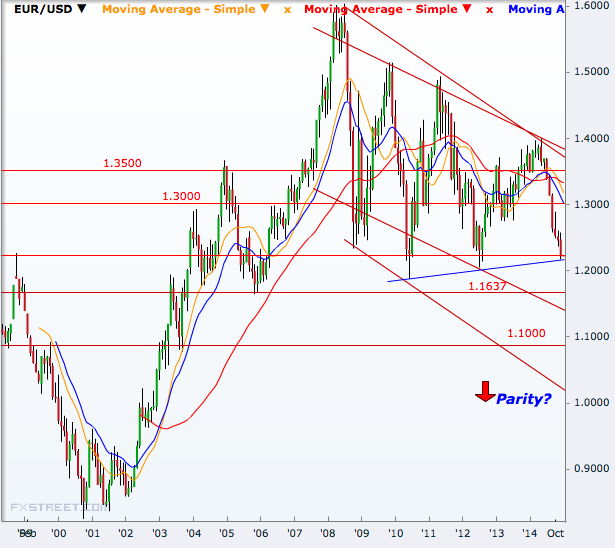Technical analysis: Will euro fall to parity versus dollar in 2015?

Charts do not show that the single currency will equal the US dollar in exchange value next year itself but they do show that the EUR/USD pair indeed is headed for parity in another year or so.
Expert fundamental views doing the rounds in the market also endorse the likelihood of parity after 2016. Goldman Sachs and Deutsche Bank have predicted it by 2017.
During the illiquid Christmas week, the EUR/USD fell to a 28-month low of 1.2164, at which the common currency was more than 11% down on the year.
Technically, the pair is visible in two medium-term downward channels, and the flatter one points to a support zone above 1.1000 while the steeper one points to a support region close to parity.
However, the fact that all the three attempts in alternate years that started in 2008 have not succeeded in decisively breaking the 1.22 support shows that the pair may be eligible for a technical bounce in the months ahead.
But with more fundamental reasons like widening interest rate and inflation divergences with the US adding to concerns that such a bounce may not materialise, new multi-year lows are what may be expected in the coming months.
So if the fourth attempt really makes it happen, then the downward channels will be in focus. The first levels to watch out for will be 1.1640 and 1.1450 ahead of levels like 1.1 and 1.0.
If the pair holds above 1.2150 in the first one month or so, then the slight rise in the wave bottoms since 2008, indicated by the blue line in the chart shown below, will attract technical analysts, so that level too may be called important.
The euro last traded at parity against the dollar in 2002, but it was during the early years' confidence crisis and therefore not really comparable to the current scenario.
After the near 100% rally in the eight years through July 2008 that took the pair to its record of 1.6040, it was trending lower. In the big picture analysis, the pair is biased downward, and the level of parity is only a question of time.
Deutsche Bank's analysts see the huge current account surplus of the eurozone will in fact do more harm than good to the currency as the savers will increasingly seek higher returns elsewhere with domestic interest rates close to zero and headed for deeper negative values.
© Copyright IBTimes 2025. All rights reserved.






















